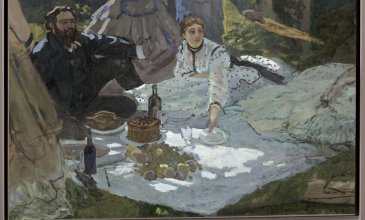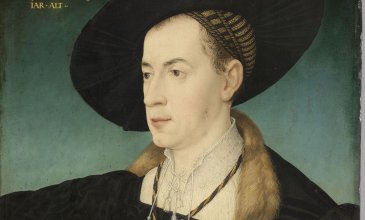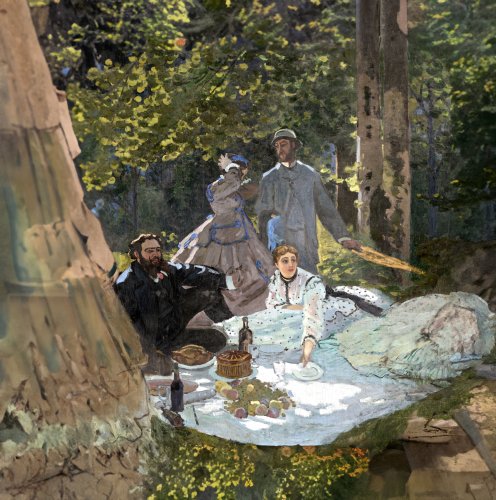Monet is in the spotlight
A work by Claude Monet at the MBAA
As part of the celebration of the 150th anniversary of the first Impressionist exhibition initiated by the Musée d'Orsay, the Musée des Beaux-Arts et d'Archéologie in Besançon will be hosting the central fragment of Claude Monet's Déjeuner sur l'herbe, painted between 1865-66, from February 24 to June 2, 2024.
The painting was cut into three fragments by the artist in 1884 (the third piece has now disappeared), and the resulting composition features four figures in a clearing. Three of them are recognizable. Alongside Camille Doncieux, the artist's companion, and Frédéric Bazille, the comrade and painter, is a man seated as if he were the master of ceremonies. He has certain features that could be those of Gustave Courbet: black hair, beard and eyes, stoutness, charisma. These physical characteristics are well known; from the outset, the artist multiplied his self-portraits, forging a public image that made him one of the most caricatured painters of the 19th century.
The artist's effigy, perhaps revisited by Monet, reveals the "Courbet character", imposing, but as if rejuvenated by the company of these new comrades. After all, Claude Monet (1840-1926) and Gustave Courbet (1819-1877) were associating at the time the work was being created: in 1866, they met at Chailly alongside Frédéric Bazille. There, Monet began work on his monumental Déjeuner sur l'herbe, which he intended for the Salon and on which Courbet kept a close eye. Exchanges were reciprocal between these two artists of different generations, but who shared certain points of view. Like Monet for his Déjeuner sur l'herbe, Courbet set up his easel in the open air for his canvases, and re-composed them in the studio. Both also worked on serial motifs, as in Courbet's Le puits noir (The Black Well), a version of which is preserved in the Musée de Besançon. The first major model for Le Déjeuner sur l'herbe was Courbet's monumental Repas de chasse (1858, Wallraf-Richatz Museum). Here we find the same powerful figures, the genre scene elevated to the level of an epic event, the attention paid to plants and nature, and the same generous still life spread out in the foreground.
The Musée des Beaux-Arts et d'Archéologie de Besançon is delighted to be able to offer its visitors, thanks to the generosity of the Musée d'Orsay, a new look at the Franc-Comtois Courbet, friend, comrade and supporter, a friend, comrade and supporter of a young generation preparing to follow him in questioning academicism, rejecting institutions and embracing freedom, and to celebrate, with this work of bold, vivid colors, brilliant light and incredible audacity, Impressionism, whose inventiveness continues to enchant us.
The painting was cut into three fragments by the artist in 1884 (the third piece has now disappeared), and the resulting composition features four figures in a clearing. Three of them are recognizable. Alongside Camille Doncieux, the artist's companion, and Frédéric Bazille, the comrade and painter, is a man seated as if he were the master of ceremonies. He has certain features that could be those of Gustave Courbet: black hair, beard and eyes, stoutness, charisma. These physical characteristics are well known; from the outset, the artist multiplied his self-portraits, forging a public image that made him one of the most caricatured painters of the 19th century.
The artist's effigy, perhaps revisited by Monet, reveals the "Courbet character", imposing, but as if rejuvenated by the company of these new comrades. After all, Claude Monet (1840-1926) and Gustave Courbet (1819-1877) were associating at the time the work was being created: in 1866, they met at Chailly alongside Frédéric Bazille. There, Monet began work on his monumental Déjeuner sur l'herbe, which he intended for the Salon and on which Courbet kept a close eye. Exchanges were reciprocal between these two artists of different generations, but who shared certain points of view. Like Monet for his Déjeuner sur l'herbe, Courbet set up his easel in the open air for his canvases, and re-composed them in the studio. Both also worked on serial motifs, as in Courbet's Le puits noir (The Black Well), a version of which is preserved in the Musée de Besançon. The first major model for Le Déjeuner sur l'herbe was Courbet's monumental Repas de chasse (1858, Wallraf-Richatz Museum). Here we find the same powerful figures, the genre scene elevated to the level of an epic event, the attention paid to plants and nature, and the same generous still life spread out in the foreground.
The Musée des Beaux-Arts et d'Archéologie de Besançon is delighted to be able to offer its visitors, thanks to the generosity of the Musée d'Orsay, a new look at the Franc-Comtois Courbet, friend, comrade and supporter, a friend, comrade and supporter of a young generation preparing to follow him in questioning academicism, rejecting institutions and embracing freedom, and to celebrate, with this work of bold, vivid colors, brilliant light and incredible audacity, Impressionism, whose inventiveness continues to enchant us.
This text was translated by an AI.
This event is available in
French
Content available online
Museum details
Address
1 place de la Révolution
25000
Besançon
+33 3 81 87 80 67
Price
Free entry with the Museums-PASS-Musées
Dates
Monday:
14:01-18:00
Wednesday - Friday:
14:00-18:00
Saturday - Sunday:
10:00-18:00
Monday:
10:00-12:30, 14:00-18:00
,
Wednesday - Friday:
10:00-12:30, 14:00-18:00
,
Saturday - Sunday:
10:00-18:00
47.239851, 6.023194

Besançon
"Monet and in the square
As part of the celebration of the 150th anniversary of the first Impressionist exhibition initiated by the Musée d'Orsay, the Musée des Beaux-Arts et d'Archéologie de Besançon will be hosting the ...
Exhibition

Besançon
Made in Germany
From May 4 to September 23, 2024, Besançon's Musée des Beaux-Arts et d'Archéologie presents an ambitious exhibition dedicated to Germanic Renaissance paintings from French public collections. Two ...
Exhibition


